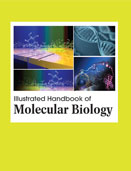Handbooks

Molecular biology concerns the molecular basis of biological activity between biomolecules in the various systems of a cell, including the interactions between DNA, RNA, and proteins and their biosynthesis, as well as the regulation of these interactions. The field of molecular biology overlaps with biology and chemistry and in particular, genetics and biochemistry. This handbook covers a wide scope of problems related to molecular and cell biology including structural and functional genomics, and transcriptomics.
Molecular biology looks at the molecular mechanisms behind processes such as replication, transcription, translation and cell function. The field of molecular biology overlaps with biology and chemistry and in particular, genetics and biochemistry. A key area of molecular biology concerns understanding how various cellular systems interact in terms of the way DNA, RNA and protein synthesis function. The specific techniques used in molecular biology are native to the field but may also be combined with methods and concepts concerning genetics and biochemistry, so there is no big distinction made between these disciplines. However, when the fields are considered independently of each other, biochemistry concerns chemical materials and essential processes that take place in living organisms. The role, function and structure of biomolecules are key areas of focus among biochemists, as is the chemistry behind biological functions and the production of biomolecules.
Illustrated Handbook of Molecular Biology effectively introduces material on biochemistry, microRNAs and RNA inhibition; functional genomics, proteomics, imaging, and stem cells. Molecular biology chiefly concerns itself with understanding the interactions between the various systems of a cell, including the interrelationship of DNA, RNA and protein synthesis and learning how these interactions are regulated. The development of molecular biology has provided a new and completely different way of understanding living organisms. The recognition of DNA as the genetic material coupled with the discovery that genes reside in chromosomes resulted in an intensive effort to map genes to specific chromosomes. Initially genes were assigned to chromosomes on the basis of correlations between modifications in cellular function, particularly biochemical defects, and the addition, loss, or modification of specific chromosomes. Recombinant DNA technology has provided molecular biology with an extremely powerful tool. In broad terms, applications of recombinant DNA technology can be divided into four areas?biomedical, basic biological, agricultural, and industrial. Biomedical applications include the elucidation of the cellular and molecular bases of a broad spectrum of diseases, as well as both diagnostic and therapeutic applications in clinical medicine. Recent advances in molecular biology and biotechnology affect our life in many ways. Today, this technology is used in preventive medicine (preparation of vaccine), in treatment (drug production), in agriculture (production of biotechnological plants and fruits) and in similar areas. For these reasons, the development of molecular biology is regarded by many people as one of the greatest revolutions in all of scientific history. Illustrated Handbook of Molecular Biology presents an in-depth understanding of the workings of living organisms from all areas of life at the molecular level. This Handbook is specially designed for the students and novice researchers within molecular biology or molecular genetics, including entomologists, evolutionary and systematic biologists, geneticists, physiologists, biochemists, and molecular biologists.